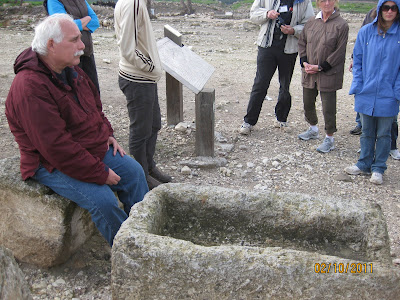We stayed in Netanya the first night; this is a view of the Mediterranean coastline with our hotel in the background
City of Caesarea

Our first stop was Caesarea, where Paul was imprisoned for 2 years. This theater is thought to be the very place where Paul gave his testimony to King Aggripa in Acts 26. Primarily it was used for plays.
An optical illusion of the theater steps.
A view of coastal Caesarea – King Herod the Great built an incredible man-made deep water port here. In this picture you can see some of the original walls still standing, along with a muslim mosque that has since been built on the site.
King Herod also built himself a nice little palace – complete with this freshwater pool (with water traveling 10 miles down an aqueduct to get here – more on that later).
Ronnie our awesome guide shows us a very recent archaeological find which has the name “Pontious Pilate” engraved in it. He is an important Biblical figure that people trying to disprove the Bible had long claimed never existed. Whoops, nice try guys.
This is a long stretch of the aforementioned aqueduct – the grading was done so precisely that it only dropped a mere 10 inches over the course of 10 miles. It brought fresh water to the city and the King's private pool.
Mount Carmel
View from the highest point of Mount Carmel, which means “vineyard of the gods.” This has long been an area of strategic military value.
Cute couple shot from Mount Carmel
Local lunch – Schnitzel on the left and Falafel on the right
A tomb recently discovered which is over 2000 years old; best represents the kind of tomb Christ would have been laid in
Megiddo National Park
This is one of the gates in the Chariot City of King Solomon at Megiddo National Park; much of the city walls are underground and still being regularly discovered by archaeological teams across the world!
This is believed to be an altar; remains of both animals and children's bones were found near the altar. This city was conquered by the surrounding Arab nations who did practice child sacrifice.
More views of internal city walls
This was a real stone manger they discovered, which our guide believes is the exact type of manger Christ would have been laid in (not a wooden one)
This was a tunnel to the city's secret water supply which was located outside of city walls – this way an opposing army putting the city under siege couldn't cut off the water.
Nazareth Village
Since the city of Nazareth has continued to modernize since the time of Christ, there is not much of anything left from that time. We visited a small village where a group had recreated a small slice of old Nazareth to show what life would have been like. Here's a picture of inside a house.
Replica of a first century olive press; crushed olives were put in a basket and had 3 varying levels of pressure applied to get different types of pure olive oil extracted.
These were winnowing forks, used to separate the wheat from the chaff
Wool had been boiled with nutshells, pomegranates, saffron, and snail shells to achieve various natural colors, then spun by hand into this yarn!
Inside of a replica home of a typical Nazareth family




















No comments:
Post a Comment